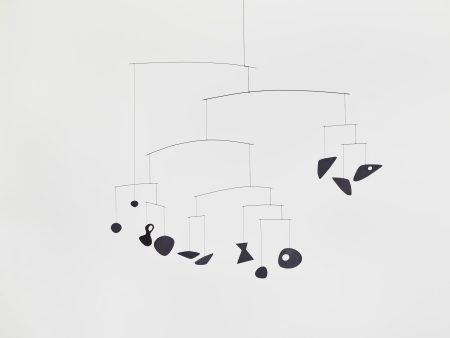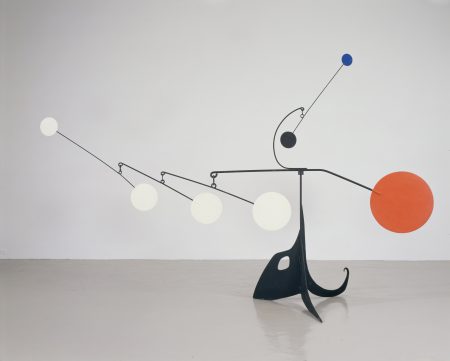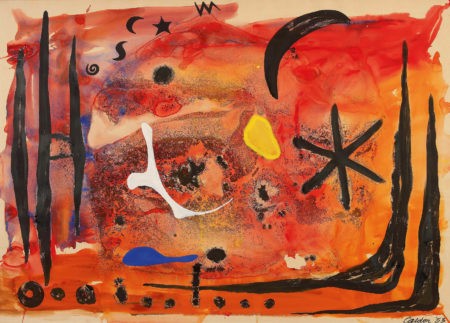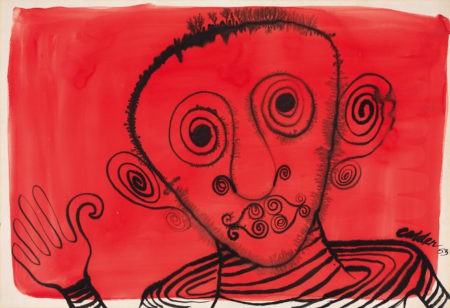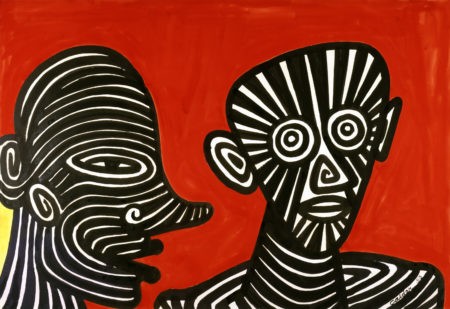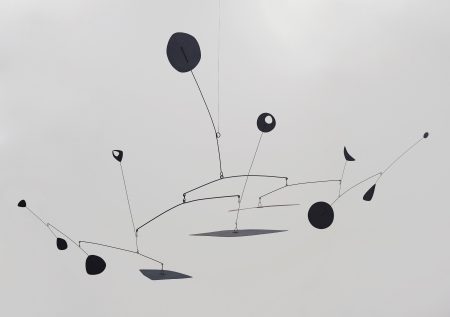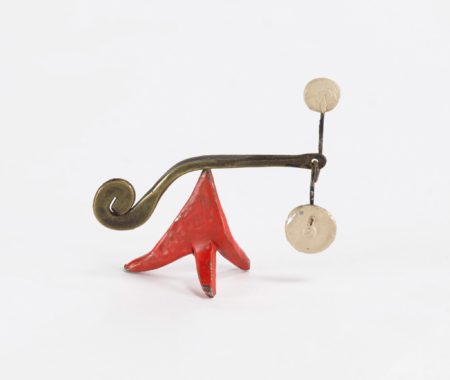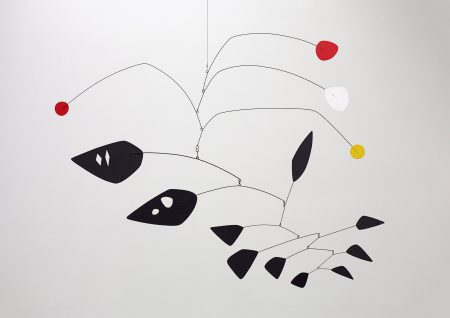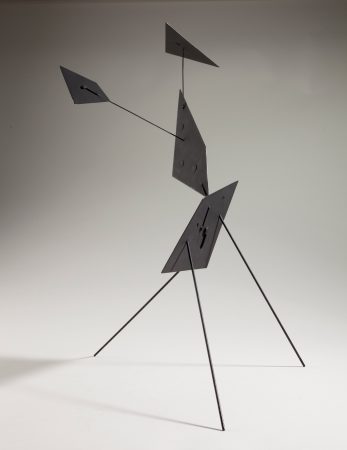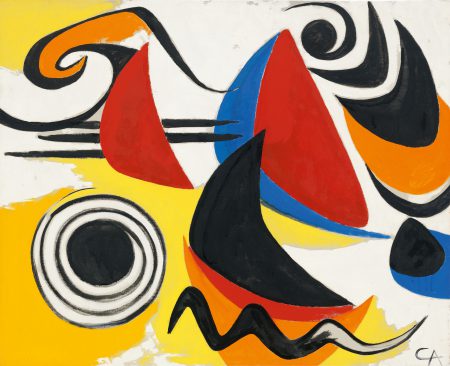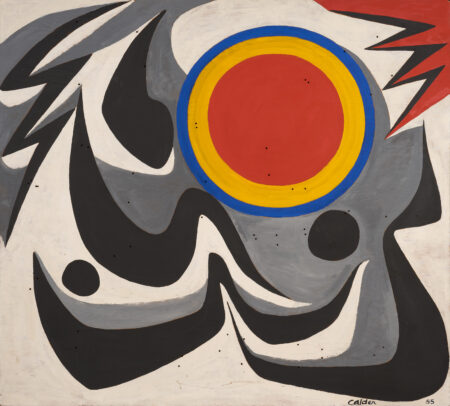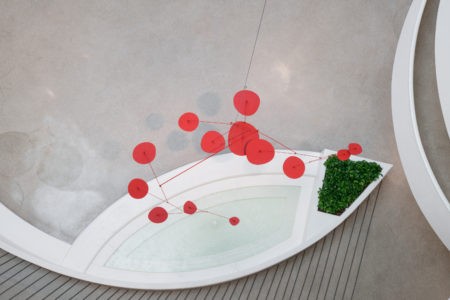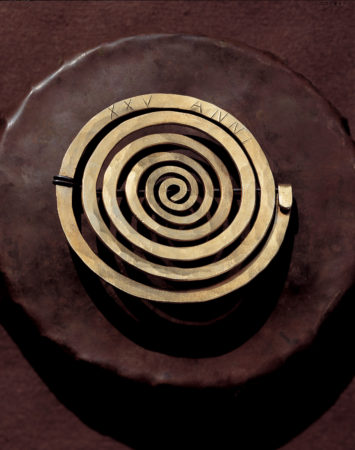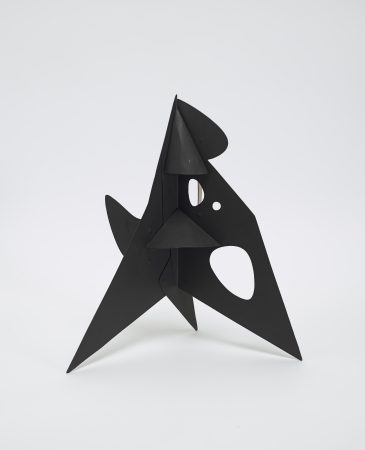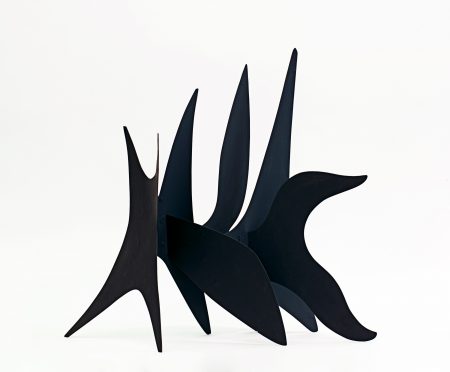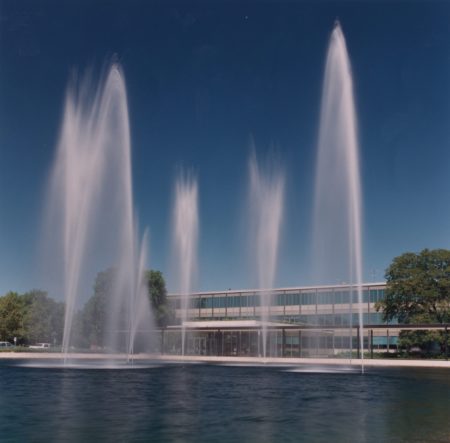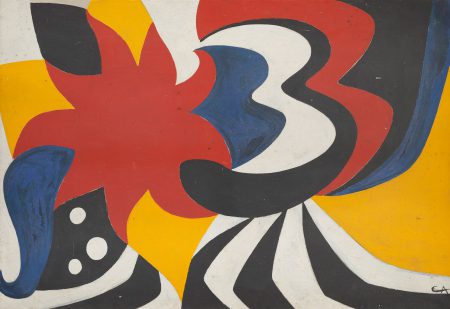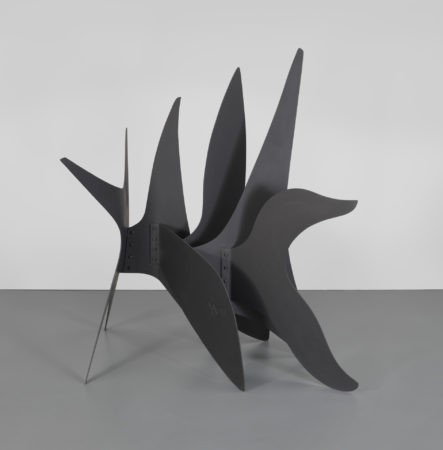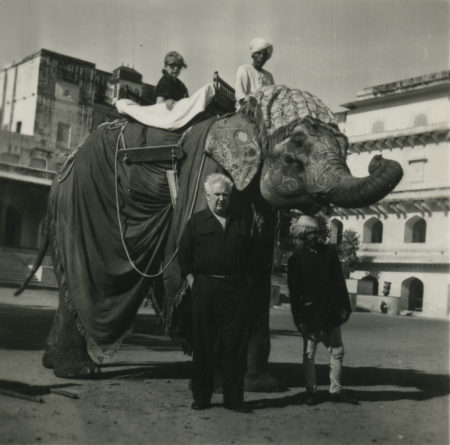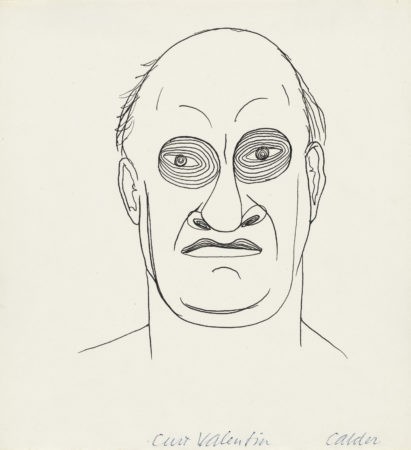Archive
See highlights from 1953–1962 on the timeline Large-scale Developments and Intercontinental Projects
Works
Exhibitions 2
Museu de Arte Moderna, São Paulo, Brazil. II Bienal do Museu de Arte Moderna de São Paulo. 15 December 1953–28 February 1954.
Group ExhibitionArts Council of Great Britain, Tate Gallery, London. Alexander Calder: Sculpture–Mobiles. 4 July–12 August 1962.
Solo ExhibitionHistorical Photos 53


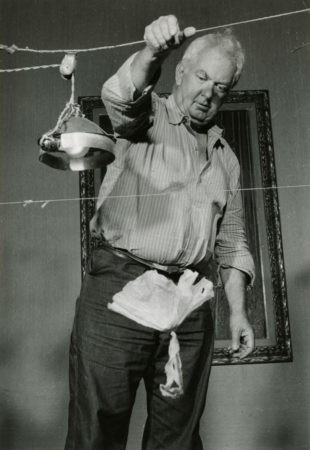



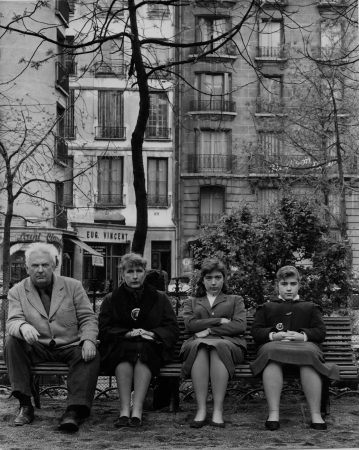


















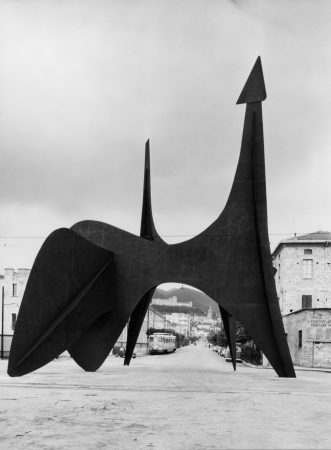



Chronology 126
Calder performs Cirque Calder in the Roxbury studio.
CF, Stillman to BreuerFrank Perls Gallery, Beverly Hills, exhibits “Alexander Calder Mobiles,” previously shown at the Walker Art Center, Minneapolis, from 22 March–19 April.
CF, exhibition fileThe Calder family arrives at Le Havre after an eight-day voyage on the Flandre. Also on board is Ernest Hemingway. He appeared suddenly and I presented myself, but it was not much use. For I had nothing to say to him and he had nothing to say to me. And that went for Louisa too.
CF, Calder to Valentin, 26 May; Calder 1966, 213The Calders arrive in the hamlet of Les Granettes in Aix-en-Provence. Their house, Mas des Roches, has little water and no electricity. Calder uses the carriage shed as his studio, where he works on gouaches. At a blacksmith shop nearby, he makes a series of large standing
mobiles conceived for the outdoors.
The Calders visit Jean Davidson in the Loire Valley. Jean has purchased a mill house Moulin Vert, in the tiny town of Saché.
Calder 1966, 219–20; CF, Calder to Peggy, 8 SeptemberCalder performs Cirque Calder at Galerie Maeght Paris.
CF, photography file
Calder receives a commission for a mobile from Middle East Airlines for their Beirut ticket office.
CF, Salaam to Calder, 30 SeptemberDaughter Sandra goes to live in Paris.
CF, Calder to Peggy, 13 October; Sandra to parents, 18 OctoberBack in Aix-en-Provence, the Calders find another house nearby, Malvalat, which has running water and electricity. Calder sets up a studio on the third floor and continues to concentrate on gouaches.
Calder 1966, 218; MoMA, Calder to Valentin, 2 November
Calder leaves Aix for Paris to begin filming Cirque de Calder, directed by Jean Painlevé.
CF, Calder to mother and the Sterns, 16 NovemberCalder visits Jean and sees his renovated mill house in Saché. Calder agrees to a trade of three mobiles for François Premier, a dilapidated seventeenth-century stone house built adjoining a cliff on Jean’s property.
Calder, 1966, 220–21Calder rigs a studio in Jean’s mill and creates the mobiles. Through the winter, Jean organizes the renovation of François Premier and converts the wagon shed into a studio. A second small building across the street serves as the “gouacherie,” a painting studio.
Calder 1966, 219–20; CF, Calder to mother and the Sterns, 16 NovemberCalder plans a trip to Beirut to visit his friend Henri Seyrig and to make the mobile commissioned by Middle East Airlines.
Calder 1966, 222; CF, Calder to mother and the Sterns, 16 NovemberMuseu de Arte Moderna, São Paulo, Brazil, presents the II Bienal. United States representation consists of three exhibitions prepared by the Museum of Modern Art, New York: two group shows and a solo show devoted to works by Calder.
CF, exhibition file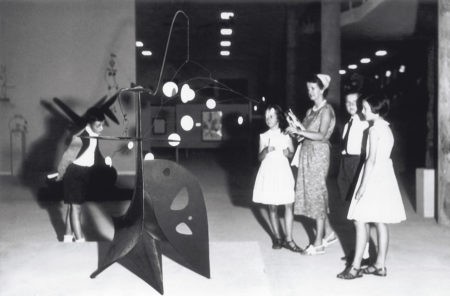
1954
The Calder family travels on the Greek steamship Aurelia from Marseilles to Greece, where they spend the day in Athens.
CF, passport; Calder 1966, 222The Calders stop in Alexandria, Egypt.
CF, passportThe Calders arrive in Beirut after a stop in Limassol, Cyprus. They reside with the Seyrigs for a month, visiting Syria and Jordan by car.
CF, passport; Calder 1966, 226Calder is given a room to serve as a studio in the Middle East Airlines ticket office, which is under construction.
Calder 1966, 226
American University, Beirut, exhibits works Calder made during the last month.
CF, exhibition fileThe Calder family visits Jerusalem and Bethlehem.
CF, passport; CF, Calder to mother, 9 FebruaryThe Calders leave Beirut by plane and return to Aix.
CF, passport; Calder 1966, 227Calder leaves Paris, traveling through Amsterdam to Hanover, where an exhibition of his work is scheduled to open at the Kestnergesellschaft.
CF, passportKestnergesellschaft exhibits “Alexander Calder: Stabiles, Mobiles, Gouaches.”
CF, exhibition fileCalder returns to Paris.
CF, passportLouisa and daughter Mary sail from Le Havre to New York.
CF, passportCalder flies from Paris to New York; daughter Sandra remains in France.
CF, passport; Calder 1966, 231The renovation of François Premier is completed.
CF, Davidson to Calder, 24 JulyCalder’s dealer, Curt Valentin, dies in Italy.
Calder 1966, 231Belgiojoso, Peressutti & Rogers of Milan build a labyrinth for the X Triennale di Milano at the Uffici Palazzo dell’arte al Parco. Calder’s Le Cagoulard is installed in the center, and Saul Steinberg’s drawings are on the walls.
CF, project fileCalder returns to France, arriving in Le Havre.
CF, passportGalerie Maeght, Paris, exhibits “Aix. Saché. Roxbury. 1953–54.” The catalogue texts are “Poème offert à Alexander Calder et à Louisa” by Henri Pichette and “Calder” by Frank Elgar.
CF, exhibition file
Calder leaves Paris and arrives in New York.
CF, passportA visa is issued for the Calders’ trip to India. Calder and Louisa have been invited by Gira Sarabhai, an architect and designer, to a tour of India in exchange for works of art.
Calder 1966, 231–32Calder and Louisa leave New York and arrive in Paris.
CF, passport1955
En route to Bombay, Calder and Louisa fly from Paris to Beirut. They visit the Seyrigs and show the film Works of Calder at the American University.
CF, passport; Calder 1966, 232The Calders arrive in Bombay. They journey by train to Gira Sarabhai’s home in Ahmedabad, where Calder makes eleven sculptures and some gold jewelry.
CF, passport; Calder 1966, 232–33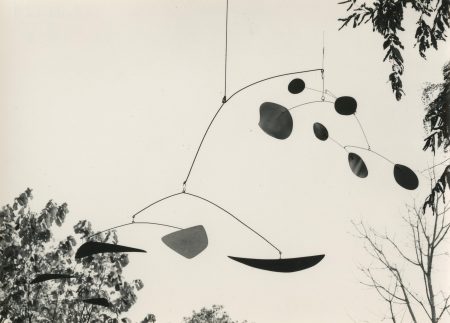
After visiting Patna, the Calders arrive in Kathmandu in Nepal.
CF, passportThe Calders leave Kathmandu for Patna from which they visit Delhi and Jaipur before returning to Bombay.
CF, passport; Calder 1966, 232–40Calder has a private exhibition in Bombay of the works he has made in India. He contracts pneumonia and stays a few extra days to recover.
Calder 1966, 239–40The Calders leave Bombay, returning to Paris via Cairo and Athens.
Calder 1966, 240; CF, passportThe Calders fly from Paris to New York.
CF, passportJehangir Art Gallery, Bombay, exhibits Calder’s work.
CF, exhibition fileCalder gifts Varda a mobile for photographing him and his work over the years. I asked Foinet to give you a mobile—your choice—among many, of a medium size that I left at the studio.
CF, Calder to Varda, 12 MayCurt Valentin Gallery, New York, exhibits “Alexander Calder.” Calder agrees to hold the show as scheduled, in spite of Valentin’s death the previous year. Nothing sells.
Calder 1966, 240Calder arrives in Caracas. He sets up a studio at the metal shop of the Universidad Central de Venezuela and sees Acoustic Ceiling installed in Aula Magna for the first time. Louisa plans to join Calder in Caracas, but a tornado hits Connecticut and causes extensive flooding; she
cancels her trip.
Villanueva arranges “Exposición Calder” at Museo de Bellas Artes, Caracas.
Calder 1966, 242; CF, exhibition file
Calder leaves Caracas, arriving in New York en route to Roxbury.
CF, passportThe Calders arrive in France for the marriage of their daughter, Sandra, to Jean Davidson.
CF, passport; Calder 1966, 246Sandra Calder and Jean Davidson are married in Saché. As a wedding present, Miró gives Sandra a drawing.
Calder 1966, 246; CF, object file
The Calders and Davidsons leave Paris and arrive in Germany, where Calder has been commissioned to make a stabile for the American Consulate in Frankfurt. The Calders stay at the Frankfurter Hof. Calder works with the bridge builders Fries et Cie to construct the monumental
stabile Hextopus.

The Calders return to France by car.
CF, passportFrom Paris, the Calders take a train to Brussels. They fly to New York and return to Roxbury.
CF, passportPantheon Books publishes A Bestiary, edited by Richard Wilbur, with illustrations by Calder.
CF, project file1956
Perls Galleries, New York, exhibits “Calder.” This is Calder’s first show with his new dealers, Klaus and Dolly Perls.
CF, exhibition fileThe Calders arrive in France.
CF, passportThe Calders drive to Italy, entering via Ponte S. Luigi. While in Rome they stay at the foot of the Janiculum Hill, where Calder sets up a studio.
CF, passport; CF, del Corso to Calder, 6 FebruaryGalleria dell’Obelisco, Rome, presents “Calder,” which travels to Galleria d’Arte del Naviglio, Milan, and Circolo della Cultura e delle Arti, Trieste.
CF, exhibition fileThe Calders leave Italy for France.
CF, del Corso to Calder, 16 AprilThe Calders leave Paris, arriving in New York en route to Roxbury.
CF, passportCalder completes his fountain commission Water Ballet for the General Motors Technical Center, Warren, Michigan. There is a dedication on 15 May.
CF, Saarinen to Calder, 27 April; CF, Dinkeloo to Calder, 17 May
The Calders arrive in Paris en route to Saché.
CF, passportThe Calders’ grandson, Shawn Davidson, is born in Tours, France, to Sandra and Jean Davidson.
Calder 1966, 252The Institute of Contemporary Art, Boston, exhibits “Jewelry and Drawings by Alexander Calder.” Forty-one pieces of jewelry are exhibited.
CF, exhibition fileThe Calders fly from Paris to New York.
CF, passport1957
Arnold Newman photographs Calder in his Roxbury home and studio.
CF, photography file
Frank Perls Gallery, Beverly Hills, exhibits “Alexander Calder.”
CF, exhibition fileCalder attends the screening of 8×8: A Chess Sonata in 8 Movements at the Museum of Modern Art. Directed by Hans Richter, the film brings together Arp, Paul Bowles, Calder, Cocteau, Duchamp, Kiesler, Jacqueline Matisse, Sert, and Tanguy, among others.
CF, project fileThe Committee of Art Advisors at UNESCO approves Calder’s maquette for a standing mobile. Titled Spirale, the mobile top is made by Calder at Segré’s Iron Works in Connecticut and the stabile bottom is made with the collaboration of Jean Prouvé in France.
CF, Evans to Calder, 15 MarchIllustrator Réne Bouché draws a portrait of Calder with Louisa and daughter Mary in Roxbury.
CF, object fileAt Waterbury Iron Works in Connecticut, Calder finishes the mobile commissioned by the Port Authority of New York. He initially titles it .125, the gauge of the aluminum elements, although the work is later dubbed Flight. The mobile is placed in a storeroom near the International Arrivals
Building of Idlewild Airport (now John F. Kennedy International Airport), where it is to be installed upon completion of the terminal.
The Calders and daughter Mary arrive in Paris.
CF, passportWhile visiting Ritou Nitzschke and André Bac in La Roche Jaune, Brittany, the Calders buy an old customs house, Le Palud, located at the mouth of the Tréguier River. A few times a year, at high tide, the house site becomes an island.
CF, Louisa to Nanette, 8 July; Calder 1966, 252–53
The family arrives in Spain for a visit with Peter Bellew (writer) and his wife Ellen. They also visit Artigas, a ceramicist, in Gallifa (Barcelona) before returning to France.
CF, passportUffici Palazzo dell’Arte al Parco, Milan, exhibits the XI Triennale di Milano. Calder makes the stabile Funghi Neri, enlarged from a maquette for the exhibition.
CF, exhibition and project filesThe Calders and daughter Mary leave Paris for London.
CF, passportThe Calders and daughter Mary leave London and arrive in New York.
CF, passportCalder and Louisa see .125 installed in the International Arrivals Terminal of John F. Kennedy Airport for the first time.
CF, project file
1958
Calder completes the motorized, monumental sculpture The Whirling Ear, a commission made for the pool in front of the United States Pavilion at the Brussels Universal and International Exhibition. The sculpture was made by Calder at Gowans-Knight in Watertown,
Connecticut.
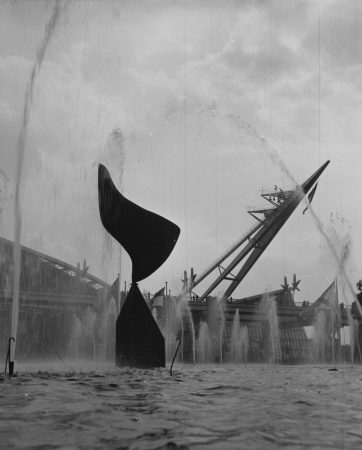
Perls Galleries, New York, exhibits “Calder, Recent Works.”
CF, exhibition fileCalder builds a second studio in Roxbury.
Lipman 1976, 335The Glory Folk, a ballet choreographed by John Butler with sets by Calder, is performed during the “Festival of Two Worlds,” Spoleto, Italy. Calder flies to Spoleto to oversee the construction of his sets.
CF, project fileThe Calders arrive in Paris.
CF, passportCalder installs Spirale, a monumental standing mobile, at UNESCO in Paris and attends the dedication ceremony on the following day.
Calder 1966, 258–59
The Calders arrive in New York.
CF, passportCarnegie Institute, Pittsburgh, presents the 1958 Pittsburgh Bicentennial International Exhibition of Contemporary Painting and Sculpture. Calder wins first prize in the sculpture category for Pittsburgh, a monumental mobile, which is purchased by G. David Thompson
and donated to Allegheny County. It is installed at the Greater Pittsburgh International Airport.
1959
Calder goes to Paris to arrange a solo exhibition at Galerie Maeght.
FJM, Calder to Prats, 24 MarchGalerie Maeght, Paris, exhibits “Calder: Stabiles.” The catalogue texts are “Stabiles” by Georges Salles and “Le Luron aux protège-genoux” by Jean Davidson, with illustrations by Calder.
CF, exhibition file
Calder leaves Paris.
FJM, Calder to Prats, 24 MarchCalder leases an apartment for daughter Mary at 20 Jones Street in New York City.
CF, lease agreementStedelijk Museum, Amsterdam, exhibits “Alexander Calder, Stabilen, Mobilen.” The catalogue texts are “Stabiles” by Georges Salles and “Calder und die mobiles” by Willem Sandberg. The exhibition travels to Hamburg, Krefeld, Mannheim, Wuppertal, and Zurich.
CF, exhibition fileCalder and Louisa host dinner at their home in Roxbury in honor of the AICA (International Association of Art Critics) XIth General Assembly.
CF, business fileThe Calders arrive in the Netherlands.
CF, passportThe Calders arrive in Le Bourget, France.
CF, passport“American Painting and Sculpture 1930–1959: The Moscow Exhibition” is included as part of the American National Exhibition in Sokolniki Park, Moscow. Calder contributes Black Mobile and 7 Legged Beast.
CF, exhibition fileThe Calders receive a visa from the Brazilian Consulate in Paris.
CF, passportThe Calders depart Paris and arrive in Rio de Janeiro, where they spend a month at the Gloria Hotel. During their stay, they visit Brazil’s new capital, Brasília.
CF, passport; Calder 1966, 253The Calders leave Brazil.
CF, passport1960
Calder is elected to the National Institute of Arts and Letters, New York, and is inducted on 25 May.
CF, awards fileThe Calders return to Brazil for the Carnaval.
CF, passportThe Calders leave Brazil, returning to the United States.
CF, passportBibliography 3
1957
Rodman, Selden, ed. “Alexander Calder.” In Conversations with Artists. New York: Devin-Adair, 1957.
General ReferenceWorld House Galleries, New York. 4 Masters Exhibition: Rodin, Brancusi, Gauguin, Calder. Exhibition catalogue. 1957.
Alexander Calder, Statement
Group Exhibition Catalogue1962
Kuh, Katharine. “Alexander Calder.” In The Artist’s Voice: Talks with Seventeen Artists. New York and Evanston, Illinois: Harper & Row, 1962.
General Reference